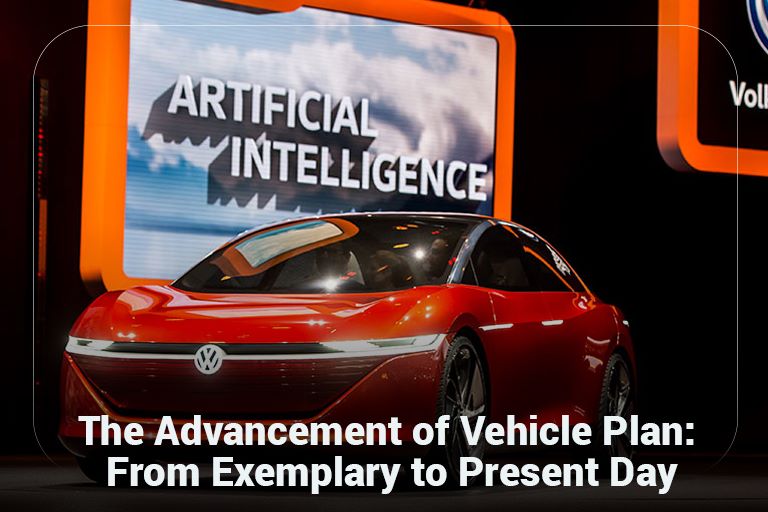The car business has gone through a momentous change over the last 100 years, and one of the most unmistakable parts of this development is the plan for vehicles. From the beginning of the auto to the present, vehicle configuration has gone through a few stages, reflecting changes in innovation, cultural inclinations, and social impacts. In this article, we will investigate the entrancing excursion of vehicle plans from exemplary to current.
- Classic Time (1900s-1940s):
The exemplary time denoted the introduction of the car business, with the main efficiently manufactured vehicles raising a ruckus around town. During this period, vehicle plans were intensely affected by horse-drawn carriages, as makers tried to acclimate individuals to this new method of transportation. Vehicles had long hoods, huge wheels, and rich bends, looking like the style of pony carriages. Wood and steel were the essential materials utilized, and extravagance highlights like calfskin upholstery and finished metal accents were normal.
- Art Deco and Smoothing out (1930s-1950s):
During the 1930s, the workmanship deco development started to shape vehicle plans. Smoothing out turned into a conspicuous element, roused by the longing to further develop streamlined features and diminish drag. This planned approach prompted sleeker, more smoothed-out vehicles with smooth, streaming lines. Adjusted bumpers, incorporated headlights, and tear shapes were normal for this period. Vehicles, for example, the Chrysler Wind Current and the Bugatti Type 57 exemplified the impact of craftsmanship deco on vehicle plans during this period.
- Post-War Innovation (1950s-1960s):
After The Second Great War, vehicle configuration went through an extreme change. The post-war time brought a restored feeling of hopefulness, and this was reflected in the cutting-edge and lavish plans of cars. Vehicles expanded, all the more impressive, and embellished with showy highlights. Chrome subtleties, tailfins, and unnecessary utilization of splendid varieties were normal. Notable models like the Cadillac Eldorado and the Chevrolet Bel Air caught the substance of this time.
- Muscle Vehicles and Sports Vehicles (1960s-1970s):
The 1960s and 1970s saw the ascent of muscle vehicles and sports vehicles, portrayed by their strong motors and forceful plans. These vehicles were about speed and execution, with smooth, low-threw bodies, wide tires, and solid lines. The Passage Colt, Chevrolet Camaro, and Avoid Charger are perfect representations of this time. Vehicle configuration started to focus on execution and the profound association between the driver and the vehicle.
- Modern Period (1980s-Present):
As we entered the 1980s, vehicle configuration began to embrace a more streamlined and eco-friendly methodology because of changing natural worries and innovative headways. The accentuation moved towards smooth and rakish shapes, with smoother lines and decreased drag coefficients. Architects started integrating PC-supported plan (computer-aided design) innovation, empowering more exact and effective prototyping. Well-being and solace include additionally became significant contemplations. Brands like BMW, Audi, and Mercedes-Benz drove the way with their moderate and refined plans.
- Digital Insurgency and Availability:
With the approach of the computerized upset, vehicle configuration has been significantly affected by progressions in innovation. The joining of computerized shows, touch screen points of interaction, and network highlights has turned into a conspicuous part of the current vehicle plan. Infotainment frameworks, GPS routes, and cell phone combinations have become the norm in numerous vehicles, offering drivers and travelers consistent and associated insight.
- Emphasis on Well-being:
Throughout the long term, vehicle configuration has progressively focused on well-being highlights. From the consideration of safety belts during the 1950s to the presentation of airbags, non-freezing stopping mechanisms (ABS), and electronic steadiness control (ESC) in later years, well-being has turned into a basic part of the vehicle plan. Crash test reproductions and high-level underlying designing methods have permitted makers to make more secure vehicles that proposition improved insurance for inhabitants.
- Innovation in Materials:
The materials utilized in vehicle configuration have additionally developed essentially. Conventional steel bodies have been supplanted, to some extent or altogether, with lightweight materials like aluminum, carbon fiber, and high-strength composites. These materials add to further developed eco-friendliness as well as proposition more noteworthy adaptability in the plan. Besides, eco-accommodating and supportable materials are getting momentum, as producers investigate choices to diminish the natural effect.
- Focus on Optimal design and Productivity:
As worries about eco-friendliness and natural effects have developed, vehicle configuration has moved towards further developed optimal design and energy proficiency. Smooth profiles, dynamic grille shades, and underbody boards are utilized to decrease drag and upgrade efficiency. Half-breed and electric vehicles highlight special plan components, like deterred front grilles and enhanced wind stream, to augment reach and effectiveness.
- Design Personalization and Customization:
Current vehicle configuration likewise recognizes the significance of personalization. Numerous producers currently offer a scope of choices for clients to modify the presence of their vehicles, including different variety decisions, combination wheel plans, and inside wraps up. This customization pattern permits proprietors to communicate their uniqueness and make a vehicle that suits their inclinations.
- Autonomous Vehicles and Future Patterns:
The car business is on the cusp of a huge change with the improvement of independent vehicles. Vehicle plan for self-driving vehicles centers around making roomy and agreeable insides and rethinking the driving experience for tenants who never again should be in charge. In addition, cutting-edge ideas highlighting expanded reality shows, adaptable guest plans, and versatile insides grandstand the capability of vehicle plans in an independent future.
- Design Impact from Different Ventures:
Vehicle configuration has frequently drawn motivation from different ventures, like flying and innovation. Streamlined standards and smooth lines propelled via airplane configuration have impacted the molding of vehicles, especially during the twentieth 100 years. Additionally, present-day vehicle plans frequently consolidate components suggestive of cell phones and innovative contraptions, with clean lines, contact touchy controls, and advanced lighting courses of action.
Conclusion:
The development of vehicle plans from exemplary to current has been an excursion of steady development and variation. From the beginning of pony-attracted carriages to the period of independent and practical vehicles, vehicle configuration has changed because of mechanical progressions, social moves, and changing buyer requests. As we look forward, the fate of vehicle configuration guarantees significantly additional interesting turns of events, as the business keeps on embracing arising innovations and the mission for more secure, greener, and more customized transportation encounters.
Read more – Economical Travel: Reclassifying The travel Industry for a Greener Future
Read more – Venture Into The Unexplored World: Investigating Odd Travel Objections











